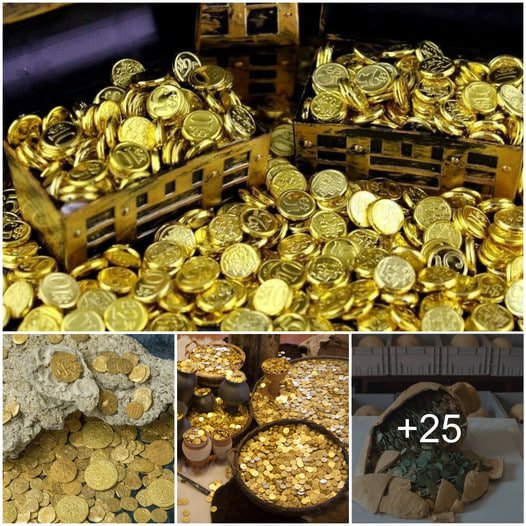
A treasure hunter stumbled upon the oldest collection of gold coins in Britain, dating back 2,173 years. Stephen Eldridge discovered 12 ancient coins from the Iron Age while scanning a field in Buckinghamshire. The British Museum confirmed that the coins were crafted by a tribe from present-day Picardy, France, around 150BC.

There is a belief that these coins were likely sent to Britain in exchange for Celtic warriors traveling to Gaul to battle the Romans. Although single gold coins from this era have been discovered in the past, finding a hoard from this time period is exceptionally uncommon.

A treasure hunter has discovered the oldest collection of gold coins in Britain, with coins that are over 2,000 years old.

Stephen Eldridge stumbled upon a collection of 12 Iron Age coins while exploring the fields of Buckinghamshire. These ancient pieces are anticipated to fetch around £30,000 when they are up for auction at Spink & Son in London. Mr. Eldridge, aged 68, made this remarkable discovery in the charming village of Ashley Green, Buckinghamshire in November of 2019. During 150BC, the region was home to the Catuvellauni tribe, who eventually emerged as the dominant tribe in Britain during the following century.

After completing the treasure process, Mr. Eldridge has decided to put the coins up for auction with London-based coin specialists, Spink. Through scientific x-ray fluorescence analysis, it was confirmed that the coins are made up of approximately 75% gold with an alloy of silver and copper, indicating the economy during the circulation of Britain’s first gold coins. Gregory Edmund from Spink & Son mentioned that while individual gold coins from this period have been found in various parts of south east England, it is extremely rare to uncover a trove of this size and date. The contemporary local coinage consisted of base metal issues known as ‘potins’, making the discovery of this trove of gold coins even more significant. Importing this valuable collection would have undoubtedly given the owner a significant amount of influence in the region.

The artifacts were determined by specialists at the British Museum to have come from a group located in present-day Picardy, France, and were crafted around 150BC.

It is likely that the ancient coins were traded for mercenaries, weapons, and hunting dogs to use in battles against the Romans and other tribes in Belgium. About twenty to thirty years later, similar British coins began to appear in the richest areas of England.

Finding a collection of coins from this era and quantity is extremely rare in archaeological findings. There has only been one other discovery of three coins from the same time period. These coins show signs of wear, indicating they were not brand new when buried, yet they still display intricate details of a unique art style from the Iron Age.

Following the treasure discovery, Mr. Eldridge has decided to sell the coins through an auction in collaboration with the renowned London-based coin experts at Spink.

X-ray fluorescence analysis in the scientific field revealed that the coins contained around 75% gold, along with silver and copper. This sheds light on the economy in which Britain’s initial gold coins were used.
There have been discussions surrounding the portraiture of these coins, which some believe was intentionally androgynous, despite being based on the male god Apollo. The feminine touch on the design likely reflects the important role of women in Iron Age society, with historical figures like Cartimandua and Boudicca becoming prominent and entering national folklore.

I find it truly fulfilling to be a part of the process of documenting, studying, and eventually selling these valuable ancient artifacts. The British Museum has decided to relinquish ownership of the coins following a coroner’s investigation, allowing them to return to the original discoverer. Mr. Eldridge has pledged to split the profits with the owner of the land where the coins were found. The coins are set to be auctioned off at Spink on Thursday.

